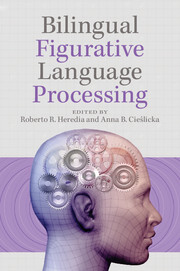Book contents
- Frontmatter
- Dedication
- Contents
- Contributors
- Acknowledgments
- Foreword
- Preface
- Section I Theoretical Implications
- Section II Methodological Approaches
- Section III Figurative Language Processing
- 6 Contrasting Bilingual and Monolingual Idiom Processing
- 7 Idiom Acquisition and Processing by Second/Foreign Language Learners
- 8 Neurophysiological Markers of Phrasal Verb Processing: Evidence from L1 and L2 Speakers
- 9 Irony Processing in L1 and L2: Same or Different?
- Section IV Cross-Linguistic Approaches and Applied Issues
- Author Index
- Subject Index
- References
9 - Irony Processing in L1 and L2: Same or Different?
Published online by Cambridge University Press: 05 February 2015
- Frontmatter
- Dedication
- Contents
- Contributors
- Acknowledgments
- Foreword
- Preface
- Section I Theoretical Implications
- Section II Methodological Approaches
- Section III Figurative Language Processing
- 6 Contrasting Bilingual and Monolingual Idiom Processing
- 7 Idiom Acquisition and Processing by Second/Foreign Language Learners
- 8 Neurophysiological Markers of Phrasal Verb Processing: Evidence from L1 and L2 Speakers
- 9 Irony Processing in L1 and L2: Same or Different?
- Section IV Cross-Linguistic Approaches and Applied Issues
- Author Index
- Subject Index
- References
Summary
Abstract
This chapter provides an overall review of irony processing research as well as evidence showing that it is not the literal/nonliteral language distinction that determines irony processing patterns, but its affective meaning. In everyday communication, next to saying what they think, speakers impart their attitudes (i.e., likes, dislikes) to express what they feel. Attitudinal content, whether explicit or implicit as in irony, is intended to shape the affective state of the hearer and prime the comprehension of the message. Implicit attitudinal meaning conveyed by ironic comments exploits this affect-driven mechanism. Recent behavioral and neuroimaging evidence shows that attitudinal content instantaneously impacts comprehension. New experimental evidence demonstrates the special role attitudinal content plays in irony processing and is consistent with behavioral and neuroimaging evidence, pointing to an affect-driven mechanism in irony processing. Based on the available experimental evidence exploring irony processing in bilingual population of Polish users of English, preliminary empirical insights point to the primary role of attitudinal content and secondary role of language in irony processing.
Keywords: affective load, bilingualism, contextual effects, implicit attitude, irony processing
Traditionally, verbal irony has been analyzed as a trope. Tropes are utterances with figurative meanings that relate to their literal meanings in one of several standard ways. In irony, figurative meaning is assumed to be the opposite of, or contrary to, the literal meaning and is based on substitution, in which the literal meaning is substituted with the figurative meaning. The major drawback of irony as a trope approach is that it neither differentiates between irony and other figures of speech nor explains how the figurative meaning is derived from linguistic evidence.
Information
- Type
- Chapter
- Information
- Bilingual Figurative Language Processing , pp. 268 - 298Publisher: Cambridge University PressPrint publication year: 2015
References
Accessibility standard: Unknown
Why this information is here
This section outlines the accessibility features of this content - including support for screen readers, full keyboard navigation and high-contrast display options. This may not be relevant for you.Accessibility Information
- 4
- Cited by
